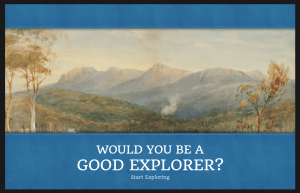
‘Would you be a good explorer?’ (WYBAGE) is an interactive, browser-based game created by the National Museum of Australia (NMA, 2020) as part of their digital learning collection on Australian history. Adopting the role of an explorer crossing the Blue Mountains in 1813, readers must utilise comprehension skills, critical thinking, and problem-solving skills to navigate multiple-choice questions as they attempt to extend the colony of New South Wales. Identified as being targeted towards years 5 and 9, this interactive game has the potential to extend to further audiences, depending on the literacy and digital competencies the learners possess (Yang et al., 2020, p. 4). As a born-digital, server-based game, WYBAGE is conveniently accessible to Australian audiences on a variety of devices. Due to its digital nature, WYBAGE may be subject to server outage or technical problems which can disrupt the readings process. The longevity of WYBAGE is also reliant on the availability of its mother-site, and the priority placed on it by the NMA.
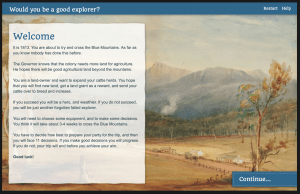
Through its user-centred design (Sellers, 2006, p. 10), the narrative gameplay of WYBAGE begins once the user selects the [start exploring] button found on the title page before transitioning to a welcome page which concisely explains the premise and rules of the game. After setting the premise, the reader must select [continue] and then make the first of many decisions. The reader must comprehend the written clues and then respond with the most appropriate answer. In total, the user will have to make several choices throughout the 11 stages of the game. Upon wise decisions, the readers narrative will progress, while in contrast, the game will end upon an unwise choice. WYBAGE takes approximately 10 minutes to successfully complete, but time variances may depend on the capabilities of the participants (Yang et al. 2020, p. 3).
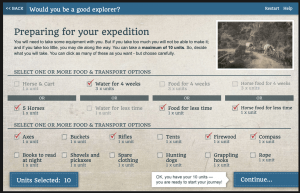
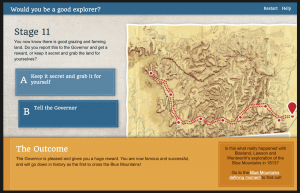
Not only does WYBAGE utilise a choose-your-own-ending style of narratological gameplay, but it also utilises embedded media (Williams, 2020, p. 24). Content appropriate images and a map (which tracks the exploration route with reader progression) have been embedded into the reading process, enhancing meaning, and encouraging critical and reflective gameplay (De Grove et al., 2012, p. 2023). The narrative itself embraces compound and straightforward sentences, traditional reading practises, and direct language (i.e., ‘you’), making for an easy and enjoyable reading experience. Upon completing the game, participants are provided with the hyperlink Blue Mountains defining Moments, that leads them to more educational materials. These hyperlinked materials include a digital gallery, a detailed account of the exploration, three student tasks, inferential questions, and an opportunity for students to share what they have learnt (James & De Kock, 2013, p. 111).
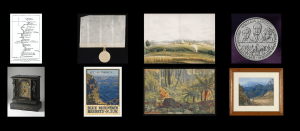
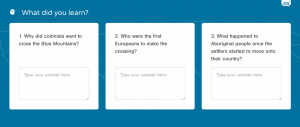
Depending on the selected platform, either computer or tablet, WYBAGE utilises interface actions of mouse clicking or finger tapping to progress the gameplay narratology (Sellers, 2006, p. 15). Through clicking or tapping, the player experiences a state of control over the narrative taking place. However, this control is illusive, as the end narrative of WYBAGE has already been predetermined by the creators (Allan, 2017, p. 25). Additionally, the repetitive actions of clicking or tapping, and poor decision-making may cause participants to feel frustrated and ultimately lead to disengagement (Jarvin, 2015, pp. 35-36). Similarly, once the game has been completed and its sequences memorised, WYBAGE may lose meaning. Even though WYBAGE applies traditional reading conventions such as left-to-right, top-to-bottom and linear narration, the implementation of embedded features enables the learning experience to extend beyond that of traditional print (Kucirkova, 2019, p. 211). However, the developers have missed an opportunity to include language choices allowing for a more global audience, read-to-me narratology, dictionary elements, text highlighting, and more multi-sensory details to creating an authentic reading experience for all (Cowdy, 2018, p.22). According to Jarvin (2015), this could potentially mean that WYBAGE is ‘edutainment’ rather than an interactive educational game as claimed by the NMA, as it tends to focus on memorising facts and narrative patterns rather than engaging readers on a higher cognitive level (p.35).
As WYBAGE explores themes of agriculture, Indigenous Australia, colonial Australia, and the Australian environment, it is a suitable tool for teaching the Australian Curriculum, meeting the general capabilities of Literacy, ICT, critical and creative thinking, and ethical decision making (ACARA). Ideally, WYBAGE could be sourced to support the learning of cross-curriculum opportunities such as Indigenous history and culture, and consequently units of work on Australian exploration; whilst in a multidisciplinary sense, WYBAGE can be utilised in English, History, and Digital Technologies (ACARA).
Word count: 753
Reference List
Australian Curriculum, Assessment and Reporting Authority (ACARA). N.D. Australian Curriculum: General capabilities. https://www.australiancurriculum.edu.au/f-10-curriculum/general-capabilities/
Australian Curriculum, Assessment and Reporting Authority (ACARA). N.D. Aboriginal and Torres Strait Islander History and Cultures. Australian Curriculum: Cross-curricular opportunities. https://www.australiancurriculum.edu.au/f-10-curriculum/cross-curriculum-priorities/aboriginal-and-torres-strait-islander-histories-and-cultures/
Australian Curriculum, Assessment and Reporting Authority (ACARA). N.D. Australian Curriculum: Learning Areas. https://www.australiancurriculum.edu.au/f-10-curriculum/learning-areas/
Allan, C. (2017). Digital Fiction: ‘Unruly object’ or literary artefact? English in Australia, 52 (2), 21-27. https://primo.csu.edu.au/permalink/61CSU_INST/15aovd3/cdi_scopus_primary_617787956
Cowdy, C. (2018). Grammars of new media: Interactive trans-sensory storytelling and empathic reading praxis in Jessica Anthony and Rodrigo Corral’s Chopsticks. Bookbird: A Journal of International Children’s Literature, 56(1), 20-27. https://muse.jhu.edu/article/687447
De Grove, F., Bourgonjon, J., Van Looy, J. (2012). Digital games in the classroom? A contextual approach to teachers’ adoption intention of digital games in formal education. Computers in Human Behaviour, 28(6), 2023–2033. https://doi.org/10.1016/j.chb.2012.05.021
James, R. & De Kock, L. (2013). The digital David and the Gutenberg goliath: the rise of the ‘enhanced’ e-book. English Academy Review, 30(1), 107-123. https://doi.org/10.1080/10131752.2013.783394
Jarvin, L. (2015). Edutainment, games, and the future of education in a digital world. The global context for new directions for child and adolescent development. New Directions for Child and Adolescent Development, 147, 33–40. https://doi.org/10.1002/cad.20082
Kucirkova, N. (2019). Children’s reading with digital books: Past moving quickly to the future. Child Development Perspectives, 13(4), 208–214. https://doi.org/10.1111/cdep.12339
National Museum of Australia. (2020). Would you be a good explorer? Australia’s Defining Moments: Digital Classroom. https://digital-classroom.nma.gov.au/games/would-you-be-good-explorer
National Museum of Australia. (2020). Conditions of Use. https://www.nma.gov.au/about/contact-us/conditions-of-use
Sellers, M. (2006). Designing the experience of interactive play., Playing video games: Motives, responses, and consequences, P. Vorderer & J. Bryant (Eds.), 9–22. Lawrence Erlbaum Associates Publishers. https://doi.org/10.1111/j.1460-2466.2006.00323.x
Williams, K, M. (2020). Point, read, think, click: Expanding new literacies in Kazakhstan and Mongolia. International Journal of Education and Development Using Information and Communication Technology, 16 (3), 16–34. https://files.eric.ed.gov/fulltext/EJ1275778.pdf
Yang, S., Lee, J.W., Kim, H., Kang, M., Chong, E.R., & Kim, E. (2020). Can an online educational game contribute to developing information literate citizens? Computers and Education, 161. https://doi.org/10.1016/j.compedu.2020.104057